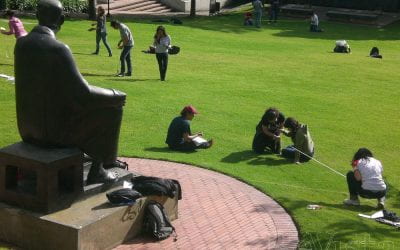Making A Difference: Literacy in Calca
A Congruent Pedagogical Home
Seated on the floor of their school house twenty attentive first grade eyes watch as Martha turns the pages and asks aloud about the fate of David a friendly llama.
“¿Por qué David esta buscando a su madre?” (Why is David looking for his mom?)
“Porqué él no sabe donde vive, quizás su madre este en la casa” (Because he doesn’t know where he lives, maybe his mother is in the house), responds Yeferson.
“¿Él está buscando su casa o su hogar?” (He is looking for his house or his home?) “¿Que es hogar?” Martha asks furrowing her brow.
“Es una casa con una familia”, “es un lugar donde una familia vive” (“It is a house with a family” “it is a place where a family lives”) They all shout.
A month ago these students, spent their forty-minute reading period at their desks. They were asked to choose any section from their first grade readers and read silently. With their teacher situated at the back of the classroom reading her own novel, they were distracted, unengaged and more importantly not reading.
We, two doctoral students at the Harvard Graduate School of Education, both previous teachers and language and literacy specialists, spent a month implementing a literacy program and studying the results in Calca, an indigenous village of 8500, situated near Cusco, Peru where we found children unengaged by reading lessons dominated by dictation, memorization and little student participation.
In 2004, 75% of first and second grader in Peru fell below grade level in literacy achievement with 98% of children in rural schools (like in Calca) scoring below grade level according to the Peruvian Ministry of Education (UMC, 2004). Moreover, in Calca, Quechua—a linguistic variety of which was spoken in the Incan Empire—is often spoken at home and Spanish is mandated at school.
We focused on vocabulary, designing and implementing a classroom curriculum based on story book Read Alouds, including the use of inferential and literal questioning, vocabulary probes, techniques to promote group discussion, and seating arrangement to promote engagement (Beck & McKeon, 20001).
Students sat in a semi circle around the teacher and the book,.We watched as the classroom atmosphere shifted to one filled with authentic learning in which the teachers asked their students questions that helped them reason and to build on their background knowledge about words and personal experiences. After only a month of intensive instruction using this method, students increased their vocabulary knowledge by 30% as compared with their peers not receiving this program. Unlike the scene a month earlier, where students were distracted and lost in other thoughts, now, they are lost in an imagination that integrates books. This pedagogy locates them in a newly found literary “hogar”. It wasn’t just student’s lives that changed. “I am inspired and motivated by this way of teaching,” said Martha, a teacher.
Winter 2008, Volume VII, Number 2
Sabina Rak Neugebauer is a doctoral student at the Harvard Graduate School of Education. Her research focuses on the diagnostic, socio-cultural and pedagogical issues that impact bilingual students. She is currently working with local stakeholders to design a children’s library in Peru and is one of the editors of the book Indigenous Knowledge and Education: Sites of Struggle Strength and Survivance (in press).
Rachel Currie-Rubin traveled to Peru with the support of the DRCLAS Summer Research Travel Grant. She is a doctoral student focusing on language and reading development at the Harvard Graduate School of Education.
Related Articles
Salvadoran Youth, Transnationalism’s Other Product
English + Español
A completely distraught junior high school teacher in the Washington DC area approached her assistant principal—a highly-educated white middle-class man—one morning for urgent…
Cuba on the Edge: Short Stories from the Island
If you want to read contemporary Cuban fiction and do not have access to the Spanish original, an increasing number of excellent translations will now allow you to become acquainted with…
Maintaining Academic Excellence in Latin American Universities
The Iniciativa para el Desarrollo de la Innovación Académica (IDIA), a teaching and learning initiative of LASPAU, helps higher education institutions in Latin America address the perennial…




